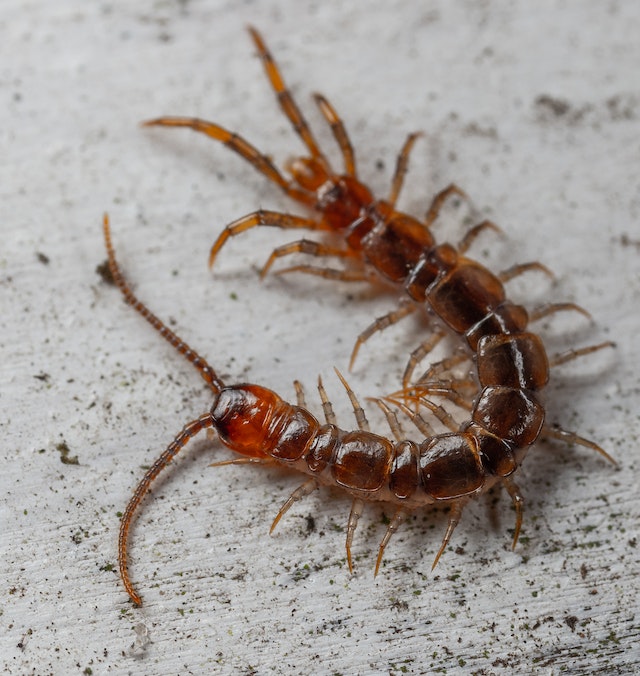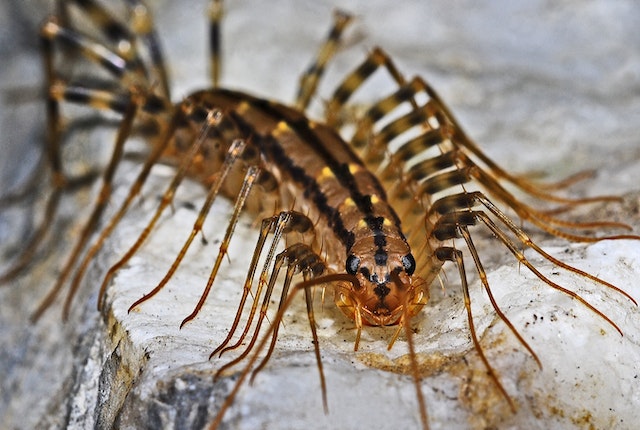
Are you tired of encountering creepy crawlies in your home? You’re not alone if you’ve noticed an abundance of centipedes scurrying around your Raleigh house. Many homeowners find themselves wondering, “Why are there centipedes in my house?”
These multi-legged creatures may be small in size, but they can quickly become a nuisance. In this blog post, we’ll explore the reasons behind the influx of centipedes and provide you with effective strategies to keep them at bay. Say goodbye to those unwelcome houseguests as we uncover the secrets to a centipede-free home.
What Types of Centipedes Come Indoors?
Several species of centipede have been known to venture indoors. The specific species that may be found in your house can vary depending on your geographical location. Here are a few common centipede types that invade indoor spaces:
- House Centipede
The house centipede is perhaps the most frequently encountered centipede species indoors in Raleigh. It has long, flattened bodies and is light brown or grayish. House centipedes are known for their agility, speed, and numerous long legs. - Stone Centipede
Stone centipedes are slender, elongated centipedes. They are usually brown or reddish-brown and have 15 pairs of legs. Stone centipedes prefer cool, moist environments and are commonly found in basements or crawl spaces. - Tropical Centipede
Although more commonly found in tropical regions, the tropical centipede can occasionally make its way indoors in certain areas. This species is large and aggressive, with a reddish-brown coloration and prominent, venomous pincers. Tropical centipedes are usually found in warm, humid climates. - European House Centipede
Similar in appearance to the house centipede, the European house centipede is also known to invade indoor spaces. It has a yellowish-gray or pale-brown coloration and moves swiftly on its numerous legs. - Brown Centipede
Brown centipedes are common in many regions and can sometimes be found indoors. They are small to medium-sized centipedes with brown or reddish-brown coloration. Brown centipedes typically have around 15 pairs of legs and prefer damp environments.
These are just a few examples of the centipede species that you may see indoors. Seeing this list may make you wonder, “Why are there centipedes in my house, and which one is invading?”

Centipede identification can be challenging, as there are numerous species worldwide and in North Carolina, each with its characteristics and habits. If you’re interested in identifying a specific centipede species found in your house, it is advisable to consult with a local extermination company like Innovative Pest Solutions.
Why are There Centipedes in my House?
With their numerous legs and quick movements, fast moving centipedes can be quite unsettling when you discover them lurking in your house.
One of the primary reasons centipedes venture indoors is moisture. These moisture-seeking creatures often flock to areas with high humidity or dampness. Places like basements, bathrooms, laundry rooms, or crawl spaces can create an ideal environment for centipedes to thrive.
The moisture provides them with the necessary conditions to reproduce and burrow down. If you have leaks, plumbing issues, or inadequate ventilation in these areas, addressing them promptly is essential to reduce the centipedes’ attraction to your home.
Another factor that can entice centipedes into your house is the availability of food sources. Centipedes primarily feed on insects, spiders, and other small arthropods. If your home has abundant prey species, it becomes an appealing hunting ground for centipedes.
Common household pests like ants, cockroaches, silverfish, or even smaller spiders can serve as a steady food source, attracting centipedes into your living spaces. Implementing effective pest control measures to reduce the population of these insects and spiders can help decrease the centipedes’ attraction.
Centipedes seek shelter and hiding spots that offer them darkness and seclusion. They prefer to stay out of sight, often hiding in cracks, crevices, cluttered areas, or beneath objects like rocks, firewood, or piles of clothing.
If your house provides ample hiding spots, it becomes an inviting refuge for centipedes. Regularly decluttering your living spaces and ensuring that objects are correctly stored can help eliminate potential hiding spots and discourage centipedes from your home.
Structural issues in your house can also contribute to centipede infestations. Gaps, cracks, or holes in your house’s foundation, walls, doors, or windows can serve as entry points for these agile creatures.
Centipedes can effortlessly squeeze through small openings, allowing them to access the interior of your home. Conduct a thorough inspection of your house and seal any potential entry points to prevent centipedes (and other pests) from infiltrating your living spaces.
They might accidentally enter through open doors or windows or hitch a ride on plants, firewood, or other objects brought indoors. While these migrations are typically temporary, addressing any entry points and taking preventive measures to avoid future incursions is essential.
Centipede Prevention and Removal
Here are some key prevention methods that can keep centipedes away from your home!
- Reduce Moisture
Centipedes are attracted to moist environments, so addressing any moisture-related issues in your home is important. Fix leaks, repair plumbing problems, and ensure proper ventilation in damp areas like basements, bathrooms, and crawl spaces. Use dehumidifiers if necessary to maintain a dry environment. - Seal Entry Points
Inspect your home for gaps, cracks, or openings in the foundation, walls, doors, and windows. Seal these entry points using caulk, weatherstripping, or other appropriate sealants to prevent centipedes (and other pests) from entering your home. - Declutter and Clean
Reduce the clutter in your living spaces, especially in storage areas like basements, closets, and attics. Remove piles of clothing, cardboard boxes, and other items that can provide hiding places for centipedes. Regularly vacuum your home to eliminate potential food sources for centipedes and their prey. - Outdoor Maintenance
Keep your yard tidy by trimming vegetation away from the exterior walls of your house. Remove debris, leaf piles, and firewood stacks from near the foundation, as they can serve as harborage sites for centipedes. Ensure that gutters and downspouts are clean and functional to prevent excess moisture buildup near your home. - Lighting Considerations
Centipedes are attracted to light, so consider using yellow or sodium vapor light bulbs for outdoor lighting. These bulbs are less attractive to insects, which, in turn, reduces the centipedes’ food source and can help minimize their presence.
You can even try some DIY approaches to manage centipedes in your home. These include:
- Sticky Traps
Place sticky traps where centipedes are frequently seen, such as corners, basements, or near entry points. The centipedes will get trapped on the adhesive surface, allowing you to remove them. - Natural Repellents
Essential oils with centipede-deterring properties, such as peppermint or citrus oil, can also be applied around potential entry points. - Reduce Prey Populations
Implement effective pest control measures with Innovative Pest Solutions to reduce the population of insects and spiders that serve as food sources for centipedes. We use appropriate methods such as baits, traps, or insecticides targeted at the specific pests you are dealing with.
If you have a persistent centipede problem or if you prefer a more comprehensive approach, it’s recommended to consult with a professional pest control service. We can assess the extent of the infestation and provide targeted treatments tailored to your situation.
Whenever you’re struggling with a pest infestation in Raleigh, North Carolina, trust the experts here at Innovative Pest Solutions to lend a hand. Contact us today!





